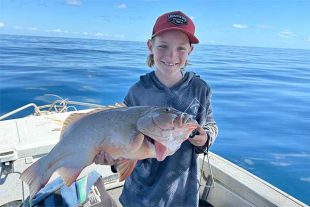AUSTRALIAN east coast spotted mackerel, scomberomorus munroi, is a pelagic fish species that forms a single genetic stock in New South Wales and Queensland waters.
Spotted mackerel exhibit schooling behaviours that form prominent spawning and feeding aggregations between Cairns and Port Stephens. When present, their highly aggregated, near surface, and catchable behaviour makes them susceptible to overfishing.
Catches of spotted mackerel peaked around 700 t in the 2001–02 fishing year. Over 90% of this harvest was from Queensland waters. In 2013–14 harvest was approximately 45% recreational and 55% commercial, with 80% of the total harvest from Queensland waters. Management changes were implemented in 2003, including a limit on ring netting and establishment of a total allowable commercial catch of 140 tonnes. Quota utilisation since then has averaged 53%, with lows of 20% and 31% harvested in 2007–08 and 2016–17 respectively, while the maximum quota utilisation of 80% was harvested in 2004–05.
The previous stock assessment for spotted mackerel included data up to 2002–03. The assessment suggested that the stock was being harvested near or exceeding sustainable levels. It suggested the biomass was in the range of 33–66% of virgin biomass. Total harvest at maximum sustainable yield (MSY) was estimated between 296–570 t and that a total harvest of less than 300 t was required to increase the biomass to MSY levels.
This stock assessment update includes annual estimates of spotted mackerel harvests up to 2016–17, along with commercial catch rates and fish age-length compositions for both commercial and recreational sectors. The assessment combined data in an annual agestructured population model tailored for the biology, management and fishing history of spotted mackerel. The age-structured population model analysed 252 scenarios based on different combinations of input data, including harvest histories, age structures, standardised catch rates and considered both high and low estimates of natural mortality.
The analyses indicated that before the limit on ring netting, fishing mortality was as high as two to three times natural mortality, and this resulted in reductions of stock size to approximately 25 40% of virgin biomass (in 1998–2004). Since the implementation of management changes fishing mortality has dropped to below limit reference points and the analyses predicted that spotted mackerel biomass has slowly increased. Lower estimates of stock size averaging around 21% of virgin biomass were obtained from scenarios that included low levels of natural mortality (M=0.42) and no standardised catch rates. In contrast, higher estimates of stock size, averaging 41% of virgin biomass, were obtained from scenarios that included high levels of natural mortality (M=0.57) and standardised catch rates.
Further detailed investigations were undertaken on a subset of eighteen of the scenarios. Of these eighteen analyses, nine provided successful model fits, with these all corresponding with the higher level of natural mortality (M=0.57). The results from the nine successful analyses suggest that the biomass of spotted mackerel in the 2016–17 fishing year ranged between 40–60%, and were therefore between trigger and target reference points. Other health parameters, including spawning egg production, recruitment and spawning per recruit were also within the trigger and target reference points.
The results suggest that the MSY harvest target is 215 t per year (including all sectors and jurisdictions). Assuming a stable level of recreational harvest of around 70 t (based on 2013–2014 Queensland statewide recreational fishing survey), total harvest (for years 2009–10 to 2016–17) has ranged between 114–207 t. This total harvest has been below the suggested MSY harvest level.
Rebuilding of the stock to 60%, as outlined by the Sustainable Fisheries Strategy, requires a total harvest between sectors and jurisdictions of 80-120 t.
To continue reading the stock assessment in its entirety, click this link.
 Bush ‘n Beach Fishing Magazine Location reports & tips for fishing, boating, camping, kayaking, 4WDing in Queensland and Northern NSW
Bush ‘n Beach Fishing Magazine Location reports & tips for fishing, boating, camping, kayaking, 4WDing in Queensland and Northern NSW









